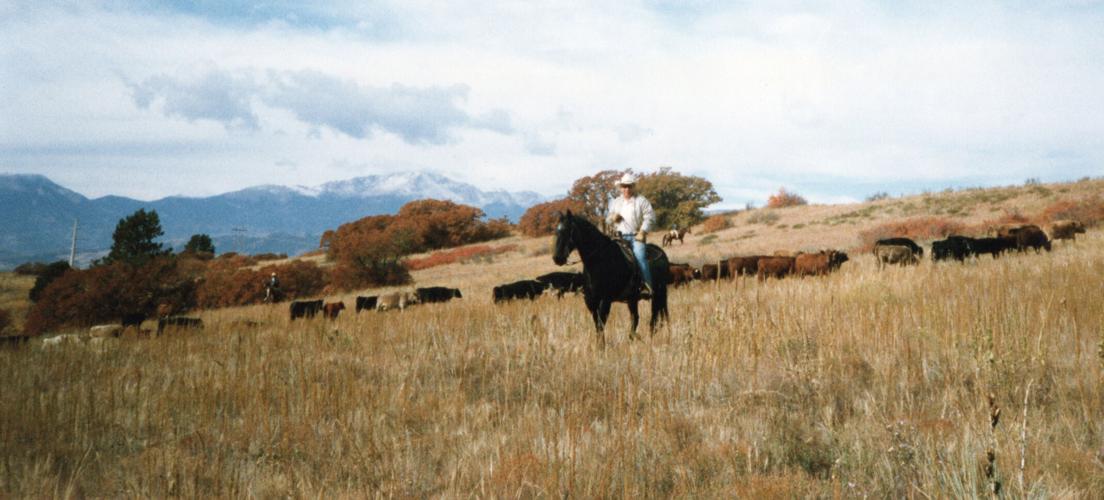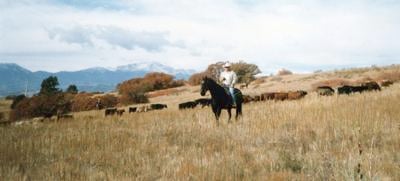When Colorado Springs rancher Thomas Allen “T.A.” Williams was growing up on North El Paso Street in the 1930s, near the Patty Jewett Golf Course, the area was on the northern edge of a modest city of about 33,000 surrounded largely by short-grass prairie.
The prairie offered plenty of space to live his dream of becoming a cowboy and being part of the rhythms of the seasons with the births of calves in the spring and their growth through the summer, T.A.’s son Tom Williams said. He welcomed others into the saddle, as well.

Brandy Williams walks along spot near Ridgeline Drive in the Flying Horse neighborhood Wednesday, where the Powers Boulevard expansion will go and where her father Thomas “T.A.” Williams was photographed on his horse Brownie in 1991 (see below).
“Anybody who was a wannabe cowboy found their way to my dad,” he recalled.
The legends and the lifestyle of cowboys are all around Colorado Springs — Hank the Cowboy stands at the intersection of Tejon Street and Pikes Peak Avenue, crowds fill the streets for Territory Days in Old Colorado City, and tourists are wowed by the skills of the riders at the Pikes Peak or Bust Rodeo.

A photo of Thomas Allen "T.A." Williams (holding the pony on the left) and his siblings from 1942. His brother Clinton who founded C+C Sand is the tall boy with the newsie-style hat. This was the family farm on the farthest northern part of Colorado Springs at the time which was North El Paso Street.
But ranching and farming as an industry has receded as homes and development have spread north, east and south and the acres of agricultural land have steadily dropped, from more than 1 million in 1940 to about 550,000 in 2020, data from the assessor’s office shows.
Homes, gas stations and shops have filled up the hills where Williams ran cattle on the outskirts of town, turning it into neighborhoods such as Briargate, roughly between Woodmen Road and Research Parkway and Flying Horse, between New Life Drive and old North Gate Road. The tree pasture where the Williams family kept their corrals became the pristine lawns and parking lot of the Pine Creek Golf Club.

THEN: A young Brandy Williams sit on her horse at the old headquarters of the Flying Horse ranch near the 7-Eleven store on Northgate Boulevard today.

NOW: The Williams family’s old headquarters of the Flying Horse ranch is now a 7-Eleven store.
It was growth T.A. didn’t foresee, Tom Williams recalled. The rancher and his friends joked that someday all the houses would be chicken coops, without people to fill them, he said. Some skepticism may have been rooted in experience, from the 1980s urban construction that continued despite an economic slowdown, leaving the community far too many unsold homes and unoccupied retail centers.
It’s also likely he didn’t understand the region’s draw, because he had never lived anywhere else, his daughter and former city councilwoman Brandy Williams said.
While the region has seen economic boom and bust, people and houses have filled up what T.A. Williams would have considered perfectly good cattle pasture. At the peak in the 1960s, more than 65,000 cows and calves lived in the county, a number that dropped down to 26,000 as of Jan. 1 this year, U.S. Department of Agriculture data shows.
At the same time, the number of people has swelled from 229,000 in 1969 to 738,000 in 2021, a regional economic project found. A tiny percentage, about 1,280, work in agriculture, state demographic data shows.

El Paso County Base Industries in 2022. Click here for the interactive chart.
It’s an industry that’s been battered as land and water have been transferred to developments, and drought over the past decade has hurt forage. The once-predictable half-hour of rain in the afternoons over Flying Horse ranch are now gone, said T.A. Williams’ wife, Consuelo. Many of those in the agricultural community add on jobs in town or other attractions, such as pumpkin patches, to help supplement their operations, she said.

Consuelo Williams walks past an old windmill next to the parking lot of the Pine Creek Golf Course last week where their family had corrals decades before.
“You don’t do it for money — you do it for pleasure, because you like it, because you love it,” she said.

Thomas Allen “T.A” Williams
T.A. Williams in his starched white shirt, Levi’s and cowboy boots watched the transformation over the decades, working far longer than most. In 2020, he sold his last cows, ending the family’s ranching endeavors, ahead of his death in August of this year at 90, his family said.
The second sibling in a family of nine kids, T.A. Williams got into the industry going to auctions, flipping cattle the way some now flip houses.
In 1945, when he was 12, he bought a calf for $1.25 and sold it for $26, Brandy recalled.
“It was kind of like gambling. Only legalized gambling,” Consuelo said.
He could calculate the value a cow was going to gain in his head, and so he kept at it into his 80s, she said.
The skill allowed him to start raising his own cattle and leasing land.
Examining growth in Colorado Springs | Full Coverage
Well before homes reached Kettle Creek, the Williams family would bring a herd of 250 cattle across Old Ranch Road and scout out the one spot where it was safe to bring them down the steep creek banks that drop 40 feet.
“You could almost kill yourself,” Consuelo said.
A good horse could make the difference, but often T.A.’s horses were simply good deals at auction, Consuelo said. One of Brandy’s horses had broken a man’s arm and so he was cheap — but they got along beautifully, Brandy said.
As a kid, Brandy had a tough time accepting the march of houses northward. So, when she was around 4, she wanted to sneak out in the middle of the night and put nails underneath the tires of equipment near Academy Boulevard and Jamboree Drive to stop development.
“It broke my heart,” she said.

A 4-year-old Brandy Williams stands next to the family corrals in the late 1970s, where the Pine Creek Golf Course is today.
When she returned from college in Pittsburgh, a newly minted engineer, development fueled her career, one with paid time off, which was a foreign concept for her dad. She worked on Pine Creek, Kettle Creek, Stetson Hills and the Shops at Briargate, among other projects.
Residents in Colorado Springs' outlying areas watch as growth creeps closer
Later as a city councilwoman, she learned the overall economic value of growth and the mantra that has driven Colorado Springs for years: Either your city is growing or it’s dying.
5 growth hotspots around Colorado Springs: A closer look
Her brother Tom described the military as an ever-present source of growth in town. Fort Carson and Peterson Air Field, now Peterson Space Force Base, went up in 1942. The Air Force Academy was built in the 1950s, followed by the Cheyenne Mountain Complex in the 1960s and what is now Schriever Space Force Base went in during the 1980s.

A cattle auction in the mid 1950s to sell the cattle on the ranch that the Air Force purchased to build the Air Force Academy.
Colorado Springs’ military culture and widespread respect for serving probably bled into his decision to attend the U.S. Military Academy at West Point, he said. He is still a soldier, now at the edge of retirement, weighing whether to return to town.
As a kid, all his best friends were from military families, and service members made their way out to the ranch to help herd and brand.
In one dramatic collision of ranch life and the military in the late 1990s, a Williams family Black Angus bull escaped from the Briargate area, crossed Interstate 25, and made it onto academy grounds. When Brandy and her dad arrived to collect it, cadets helped load the bull into a trailer. But they didn’t give the bull enough slack in the ropes, she said.
“We ended up choking the bull. So now, we have a 2,000-pound bull, that’s not going to help at all,” she said.
They did end up getting the bull into the trailer, she said, and gave the cadets a story they probably still tell today.
There’s no room for bulls in Briargate today, and hasn’t been for decades. The development pushed T.A. Williams to expand his business interests into Nebraska and Wyoming. His Wyoming ranch covered 20,000 acres and proved a battleground with coyotes, Consuelo said.
He was comfortable with the growth until the last decade of his life, when he wanted to leave because Colorado Springs had gotten so big.
Consuelo, however, is unbothered by the growth that surrounds the house near Voyager Parkway and Old Ranch Road that she moved into with T.A. in 1983. Development brought city conveniences within a five-minute drive and the 2.5-acre lot screens her home from suburbia.
The nearby Briargate development is also not a source of heartache. Conseulo and Brandy like how its developer, John Venezia, preserved mature trees, set aside scenic spots as parkland, and put in roads that could absorb future growth.
It’s an example of the style of future growth they would like to see.
Who Are We? What the population numbers for El Paso County and Colorado Springs show
El Paso County could reach 1 million people by 2050, a number Brandy described as daunting.
Growth staves off the death of a community, but it also takes a plan to grow well.
“Let’s plan for it. If it takes 20 years, we are ready. If it takes 40 years, we are still ready,” she said.
This story has been updated to correct where Brandy Williams attended college.

















(0) comments
Welcome to the discussion.
Log In
Keep it Clean. Please avoid obscene, vulgar, lewd, racist or sexually-oriented language.
PLEASE TURN OFF YOUR CAPS LOCK.
Don't Threaten. Threats of harming another person will not be tolerated.
Be Truthful. Don't knowingly lie about anyone or anything.
Be Nice. No racism, sexism or any sort of -ism that is degrading to another person.
Be Proactive. Use the 'Report' link on each comment to let us know of abusive posts.
Share with Us. We'd love to hear eyewitness accounts, the history behind an article.